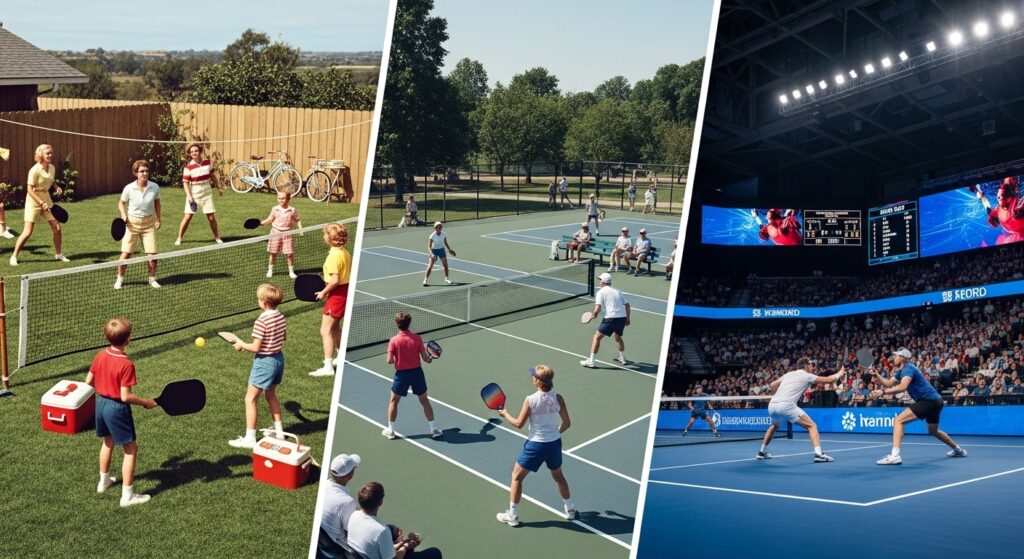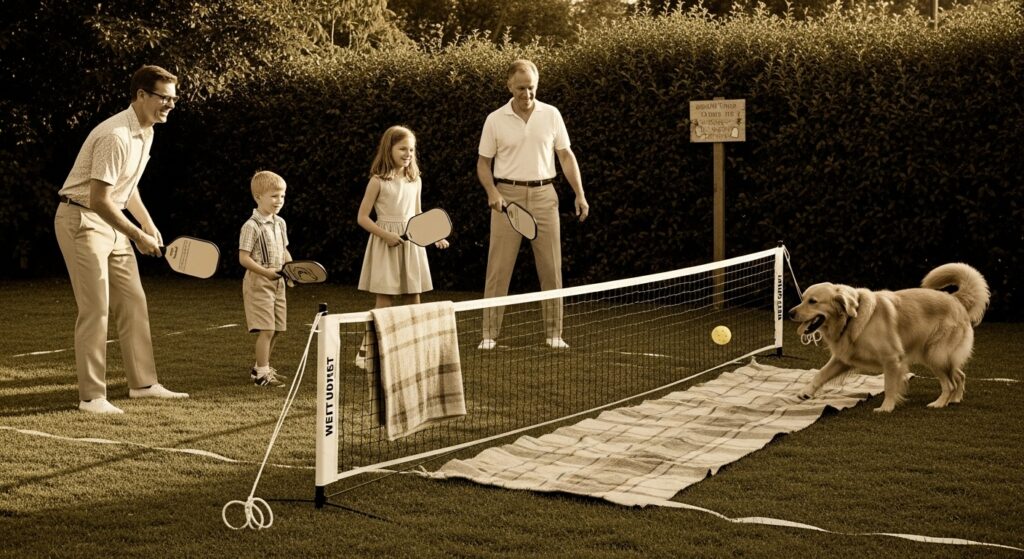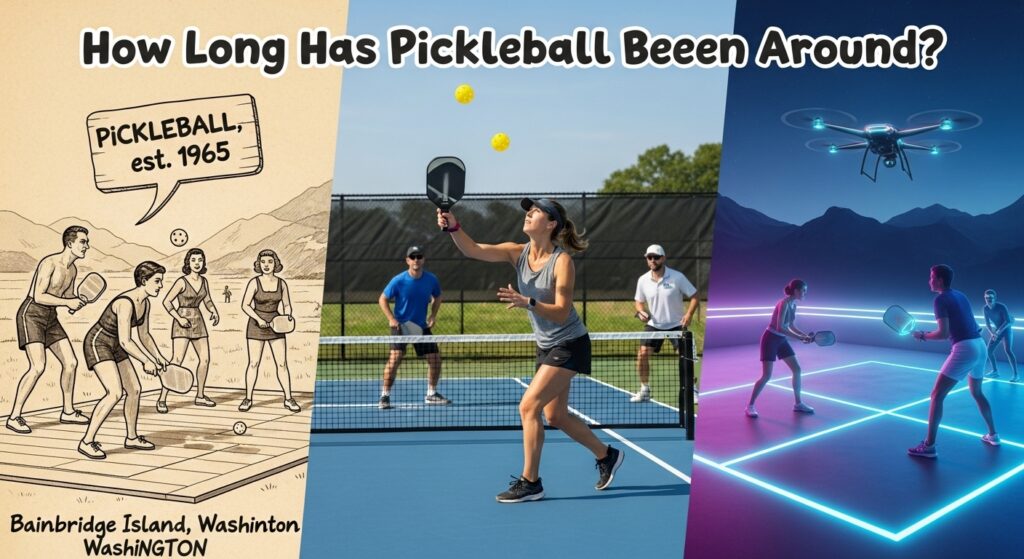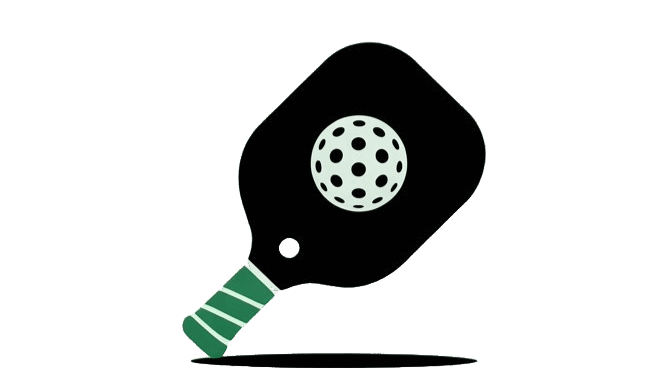Pickleball is everywhere. It seems like just yesterday, the sport was a niche hobby played in a few retirement communities. Now, it’s recognized as the fastest-growing sport in the world, with new courts popping up in parks, schools, and dedicated clubs daily.
Millions of people are discovering its unique blend of tennis, badminton, and ping-pong. This explosive growth has left many newcomers and seasoned players alike asking the same questions: Where did this game with the funny name come from? Who invented it? And how did it conquer the world?
The story of pickleball is not one of corporate boardrooms or complex marketing strategies. Instead, the origin of pickleball is a tale of summer boredom, family fun, and pure ingenuity. It’s a story that begins in a backyard on a sleepy island, with three fathers trying to entertain their kids.
This article dives deep into the complete history of pickleball, tracing its journey from a simple, improvised game to the global phenomenon it is today. We will explore where pickleball was invented, who invented it, and settle the great debate about how it got its name.
Also Read The Rise of Pickleball.
Where Was Pickleball Invented?
The story of pickleball begins in the summer of 1965 on Bainbridge Island, Washington. This scenic island, just a ferry ride away from Seattle, became the accidental birthplace of a sport that would one day captivate millions. The setting was the home of Joel Pritchard, a Washington State congressman who would later become the state’s lieutenant governor.
His property featured an old badminton court, but on one particular afternoon, Pritchard and his friends couldn’t find a full set of badminton rackets. Faced with a group of bored children and a desire for some family-friendly competition, they decided to improvise. This single moment of resourcefulness on a lazy summer day set the stage for the creation of a brand-new game.
The initial game was a mishmash of different sports. They lowered the badminton net, grabbed some table tennis paddles they had on hand, and used a perforated plastic ball. The game they created was instantly engaging, easy for everyone in the family to play, regardless of age or athletic ability.
The court on Bainbridge Island became the first-ever pickleball court, and the casual games played there laid the foundation for the official rules and equipment that would follow. The origin of pickleball is a perfect example of how simple fun can evolve into something much bigger.

Who Invented Pickleball?
While the game was born at Joel Pritchard’s home, he wasn’t alone in its creation. The invention of pickleball is credited to three friends and fathers: Joel Pritchard, Bill Bell, and Barney McCallum. These three men, all successful in their respective fields, worked together to transform their initial backyard experiment into a structured sport with defined rules.
The Founding Fathers and Their Roles
Joel Pritchard: As the host and a key instigator, Pritchard’s desire to create a game for his entire family was the spark that started it all. He was a natural leader and a public figure, which later helped in spreading the word about their new creation. His home on Bainbridge Island is now considered a historic site for pickleball enthusiasts.
Bill Bell: A successful businessman, Bell was present with Pritchard on that first day. Like Pritchard, he was looking for a new activity that was less demanding than tennis but still offered a good workout and competitive fun. He was instrumental in the early days of playing and refining the game alongside the Pritchards.
Barney McCallum: McCallum was introduced to the game shortly after that first weekend. He quickly became captivated by its potential. With a background in business, McCallum was the one who saw the game as more than just a backyard pastime. He was crucial in formalizing the sport. It was McCallum who helped create the first purpose-built paddles. Dissatisfied with the easily broken table tennis paddles, he experimented with plywood in his garage, crafting a more durable and effective paddle that became the standard for early players.
Creating the First Rules
As the game’s popularity grew among their friends and neighbors, the three men realized they needed a formal set of rules. The initial objective was simple: hit the ball over the net and keep it within the boundaries of the badminton court. However, they soon identified a problem. Taller, more aggressive players could stand at the net and smash the ball, making the game unbalanced and less enjoyable for others.
To solve this, they created one of pickleball’s most distinctive features: the non-volley zone, or “the kitchen.” This seven-foot area on either side of the net is a zone where players cannot hit the ball out of the air (a volley). This simple rule prevented players from dominating at the net and encouraged the longer, strategic rallies, known as “dinking,” that define the sport today.
They also established the “double-bounce rule,” which states that after the serve, the receiving team must let the ball bounce once before returning it, and the serving team must also let the return bounce once before hitting it. Only after these first two bounces can players begin to volley the ball. This rule further extended rallies and placed a greater emphasis on strategy over pure power.
In 1967, the first permanent pickleball court was constructed in the backyard of Bob O’Brian, a neighbor of Pritchard. This marked a significant step, moving pickleball from a temporary setup on a badminton court to a sport with its own dedicated space. The combination of Pritchard’s vision, Bell’s enthusiasm, and McCallum’s practical contributions transformed a simple idea into a legitimate sport, ready to expand beyond Bainbridge Island.
How Did Pickleball Get Its Name?
One of the most enduring and debated topics in the history of pickleball is the origin of its quirky name. How did a sport involving paddles and a plastic ball end up being called “pickleball”? There are two popular stories that have been told for decades, one involving a family dog and the other a nautical term.
The Dog Named Pickles Theory
The most charming and widely circulated explanation is that the game was named after the Pritchard family’s dog, Pickles. According to this version of the story, the cocker spaniel had a habit of chasing after the stray plastic balls and running off with them. In honor of their furry ball thief, the family supposedly named the new game “pickleball.”
This story was a favorite of Joel Pritchard’s wife, Joan. She often recounted how the dog’s antics were a memorable part of those early games. The idea of a sport being named after a beloved family pet is endearing, and it’s easy to see why this tale became so popular. For years, the story of Pickles the dog was accepted as fact by the growing pickleball community.
The “Pickle Boat” Theory
The second explanation has its roots in the world of competitive rowing, or crew. Joan Pritchard had a background in collegiate rowing at Marietta College. In crew, the “pickle boat” is the term used for the last boat to finish a race. It is typically filled with a motley crew of leftover rowers who weren’t chosen for the more competitive boats.
According to Barney McCallum and other early players, Joan Pritchard remarked that the new game reminded her of the pickle boat because it was created by throwing together bits and pieces from other sports—much like a pickle boat crew is assembled from leftover rowers. This theory suggests that the name came from the eclectic, improvised nature of the game itself. Joel Pritchard himself reportedly confirmed this version of the story in interviews before he passed away.
Which Story is True?
So, was pickleball named after a dog or a boat? For a long time, the debate continued. However, in recent years, a consensus has emerged that favors the “pickle boat” theory as the original source of the name.
According to several sources, including Barney McCallum, the family dog, Pickles, was actually acquired a couple of years after the game was invented in 1965. This timeline makes it unlikely that the game was named after him. It seems more probable that the dog was named after the game, not the other way around. The family likely found it amusing to name their new puppy after their increasingly popular backyard invention.
While the story of Pickles the dog is a fun piece of folklore that has become part of the sport’s identity, historical evidence points toward the “pickle boat” as the true origin of the name. It’s a fitting name for a sport born from a combination of different elements, created on the fly to make something fun and inclusive for everyone. Regardless of which story you prefer, the unique name has undoubtedly contributed to the sport’s memorable and approachable character.

How Long Has Pickleball Been Around?
Pickleball celebrated its 60th anniversary in 2025. What started as a spontaneous backyard game in 1965 slowly but surely gained a foothold, evolving over decades from a local curiosity into a nationally recognized sport. The growth of pickleball was not an overnight explosion but a gradual process built on grassroots enthusiasm.
The First Two Decades: 1965-1984
After its invention in 1965, pickleball remained a well-kept secret among the families on Bainbridge Island for a few years. Barney McCallum was instrumental in pushing the game beyond their immediate circle. In 1967, the first dedicated pickleball court was built. By the early 1970s, the game’s popularity had spread through word of mouth.
A pivotal moment came in 1972 when McCallum filed for a corporation to protect their creation, naming it Pickle-Ball, Inc. This step legitimized the sport and allowed them to manufacture and sell starter kits, which included wooden paddles, plastic balls, and a rulebook. These kits were essential for spreading the game beyond Washington state.
The sport’s growth reached a new level in 1976. That spring, the first known pickleball tournament in the world was held at the South Center Athletic Club in Tukwila, Washington. While early players were mostly recreational, this tournament marked the beginning of competitive pickleball. A 1976 article in Tennis magazine introduced pickleball as “America’s newest racquet sport,” bringing it to the attention of a much wider audience.
By the early 1980s, pickleball was gaining momentum across the country, particularly in the Pacific Northwest and Sun Belt states like Arizona and Florida, where it became a popular activity in retirement communities.
The Foundation of the USAPA
A major milestone in the history of pickleball occurred in 1984 with the formation of the United States Amateur Pickleball Association (USAPA). This organization was created to promote the growth and development of pickleball on a national level. The USAPA published the first official rulebook for the sport and worked to standardize gameplay across the country.
With a governing body in place, the sport gained credibility. The USAPA (which was later rebranded as USA Pickleball in 2020) was instrumental in organizing tournaments, sanctioning official events, and maintaining the integrity of the rules.
The founding of the USAPA marked the end of pickleball’s infancy and the beginning of its journey toward becoming a mainstream sport. By the end of its first two decades, pickleball had a name, a set of rules, a governing body, and a passionate, growing community of players.

Growth Timeline of Pickleball
From a few families on Bainbridge Island to millions of players worldwide, the growth of pickleball has been remarkable. This timeline highlights the key milestones that transformed a backyard game into a global sensation.
1965: The Invention
- Joel Pritchard, Bill Bell, and Barney McCallum invent the game on Bainbridge Island, Washington, using table tennis paddles, a perforated plastic ball, and a lowered badminton net.
1967: The First Permanent Court
- The first court built specifically for pickleball is constructed in the backyard of Bob O’Brian, a neighbor of the Pritchards. This signals a move from a temporary game to a more permanent fixture.
1972: Pickle-Ball, Inc. is Formed
- Barney McCallum incorporates Pickle-Ball, Inc. to manage the sport’s growth and meet the increasing demand for equipment. The company begins selling starter sets with wooden paddles and plastic balls.
1976: The First Tournament and National Exposure
- The first-ever pickleball tournament is held at the South Center Athletic Club in Tukwila, Washington.
- Tennis magazine publishes an article about pickleball, introducing the sport to a national audience of racquet sports enthusiasts.
1984: USAPA is Established
- The United States Amateur Pickleball Association (USAPA) is founded to organize and promote the sport across the country. They publish the first official rulebook.
1990: Pickleball in All 50 States
- By the start of the decade, pickleball is being played in all 50 states, thanks to the efforts of ambassadors and the growing popularity of the sport in community centers, schools, and retirement villages.
2001: The Game Arrives in Arizona
- Pickleball is introduced at the Arizona Senior Olympics, an event that draws thousands of athletes. This event was a catalyst for the sport’s explosive growth in the Sun Belt, a region that remains a pickleball hotspot today.
2005: USA Pickleball is Created
- The existing USAPA is reorganized as USA Pickleball (USAP), creating a new corporation and a dedicated board of directors to manage the rapidly growing sport.
2008: First Media Coverage
- ABC’s “Good Morning America” broadcasts a live segment on pickleball from a community in Arizona, showcasing the game to millions of viewers and sparking a new wave of interest.
2009: The First USAPA National Tournament
- The first USAPA National Championships are held in Buckeye, Arizona, attracting nearly 400 players from 26 states and several Canadian provinces. This event established a new standard for competitive pickleball.
2010: International Growth
- The International Federation of Pickleball (IFP) is founded to help promote the sport and introduce it to new countries. This marks the beginning of pickleball’s organized global expansion.
2016: The US Open Pickleball Championships
- The first-ever US Open Pickleball Championships are held in Naples, Florida. The event draws nearly 1,000 players and establishes itself as one of the premier tournaments in the sport.
2019: The Rise of Professional Tours
- The Association of Pickleball Professionals (APP) and the Professional Pickleball Association (PPA) are formed, creating dedicated tours for professional players with significant prize money. This solidifies pickleball’s status as a professional sport.
2020s: Explosive Growth and Mainstream Recognition
- The Sport & Fitness Industry Association (SFIA) names pickleball the fastest-growing sport in America for multiple consecutive years.
- Major media outlets like ESPN begin broadcasting professional tournaments.
- High-profile investors, including athletes like Tom Brady, LeBron James, and Kevin Durant, purchase professional pickleball teams, bringing unprecedented attention to the sport.
- By 2023, the number of players in the United States is estimated to be over 36 million, a testament to its incredible journey from a simple backyard game.
Fun Facts About Pickleball History
The official history of pickleball is full of key dates and milestones, but the sport’s journey is also peppered with interesting and quirky details. These fun facts offer a glimpse into the humble and often humorous evolution of the game.
1. The First Paddles Were Homemade from Plywood.
Before you could buy high-tech carbon fiber paddles, players had to make their own. When the initial table tennis paddles kept breaking, Barney McCallum went to his garage and cut new paddles out of plywood. These early paddles were heavy and crude, but they were durable enough for the game. For years, homemade wooden paddles were the standard.
2. The Ball Hasn’t Changed Much.
While paddles have evolved dramatically, the ball has remained surprisingly consistent. The game was started with a Cosom Fun Ball, a brand of perforated plastic ball that was readily available in the 1960s. Today’s pickleballs are specially engineered for the sport, but they still closely resemble that original Wiffle-style ball.
3. The “Kitchen” Rule Confused People from the Start.
The non-volley zone, or “kitchen,” is one of pickleball’s defining features, but it has always been a source of confusion for new players. The founders created the rule to stop people from smashing the ball at the net, but explaining that you can stand in the kitchen but can’t volley from it has been a challenge for instructors since 1965.
4. The Original Net Height Was 36 Inches.
The game was first played on a badminton court with the net at its original height of 60 inches. The founders quickly realized this was too high and lowered it to 36 inches, the height of a tennis net at the sidelines. They eventually settled on a height of 34 inches at the center, which remains the official standard today.
5. Pickleball Was a Family Affair.
The children of the inventors were the first-ever pickleball players. Frank Pritchard, son of Joel, is credited with coining the “kitchen” term. He told his dad that you stay out of the kitchen unless you have a reason to be in there, and the name stuck.
6. The First “Official” Food of Pickleball Was… Pickles!
In a nod to the game’s name, early tournaments often served pickles to the players. This playful tradition helped solidify the sport’s fun-loving and social identity.
7. Celebrities Are Now Team Owners.
The sport has attracted big-name investors from the worlds of sports and entertainment. Super Bowl champion Tom Brady, NBA legends LeBron James and Kevin Durant, and former tennis star Kim Clijsters are all part of ownership groups for Major League Pickleball (MLP) teams. This celebrity involvement has brought massive media attention to the sport.

Pickleball’s Evolution Into a Global Sport
The journey of pickleball from a backyard game to a global sport is a story of grassroots passion meeting smart organization. Its growth was organic, spreading from community to community before exploding onto the international stage.
The American Expansion
In the United States, pickleball’s growth was driven by two key demographics: seniors in retirement communities and students in physical education classes.
For retirees, the sport offered the perfect combination of social interaction, low-impact exercise, and friendly competition. The smaller court and slower ball speed made it accessible to players who might find tennis too physically demanding. Sun Belt states like Florida and Arizona became early adopters, with massive retirement communities building dozens of courts to meet demand.
At the same time, physical education teachers saw pickleball as an ideal sport for schools. The rules are simple to learn, the equipment is relatively inexpensive, and it can be played in a gym or on a converted tennis court. It taught hand-eye coordination and teamwork in a format that was fun and inclusive for students of all athletic abilities.
International Adoption
By the 2000s, American “snowbirds” who traveled to warmer climates for the winter began introducing the game to their friends in Canada. This cross-border sharing established Canada as one of the first countries outside the US to embrace pickleball.
The formation of the International Federation of Pickleball (IFP) in 2010 was a turning point for global expansion. The IFP worked with ambassadors to introduce the sport to countries across Europe, Asia, and Oceania. Nations like Spain, the United Kingdom, India, and Australia started forming their own national governing bodies.
The UK, in particular, has seen rapid growth, with pickleball clubs forming across the country. In Asia, countries like India and Thailand are seeing a surge in popularity, driven by a growing middle class looking for new recreational activities.
The Rise of Professional Pickleball and Olympic Dreams
The 2010s marked the professionalization of the sport. The creation of the PPA and APP tours established a clear path for elite players to earn a living from pickleball. With prize purses now reaching into the millions and broadcast deals with major networks like ESPN and CBS Sports, professional pickleball is a legitimate spectator sport.
The ultimate goal for many in the pickleball community is inclusion in the Olympic Games. For a sport to be considered for the Olympics, it must be played in a significant number of countries and have a robust international federation.
With over 80 member nations in the IFP and counting, pickleball leaders are actively working toward meeting the criteria for Olympic consideration, potentially for the 2032 or 2036 Games. The dream of seeing pickleball on the world’s biggest sporting stage is now a real possibility.
Also Read Where to Play Pickleball: Courts, Clubs & Community Guide ?
FAQs About Pickleball History
Who invented pickleball?
Pickleball was invented in 1965 by three fathers: Joel Pritchard, Bill Bell, and Barney McCallum.
Where was pickleball first played?
The first games of pickleball were played on an old badminton court at Joel Pritchard’s home on Bainbridge Island, Washington.
Why is it called pickleball?
The most widely accepted story is that it was named after the “pickle boat” in crew, which is a boat made up of leftover rowers. This reflects how the game was created from a mix of different sports. The popular story about it being named after a dog named Pickles is likely a myth, as the dog was acquired after the game was invented.
How old is pickleball in 2025?
Since it was invented in the summer of 1965, pickleball turned 60 years old in 2025.
Was pickleball named after a dog?
No, this is a common misconception. Evidence suggests the family dog, Pickles, was named after the game, not the other way around. The name originated from the term “pickle boat.”
Conclusion
The history of pickleball is as unique and charming as the sport itself. What began as a solution to summer boredom for three families on Bainbridge Island has blossomed into a global movement. Its origin story rooted in family, fun, and creativity is a perfect reflection of the sport’s culture today. Pickleball’s success lies in its accessibility; it’s a game that welcomes everyone, regardless of age, background, or athletic prowess.
From the first handmade wooden paddles to the professional tours broadcast worldwide, the growth of pickleball has been a testament to its passionate community. As millions more pick up a paddle for the first time, they become part of a story that started over 60 years ago in a backyard in Washington. The little game with the funny name has not only arrived—it’s here to stay.
Also Read About Rules of Pickleball.






